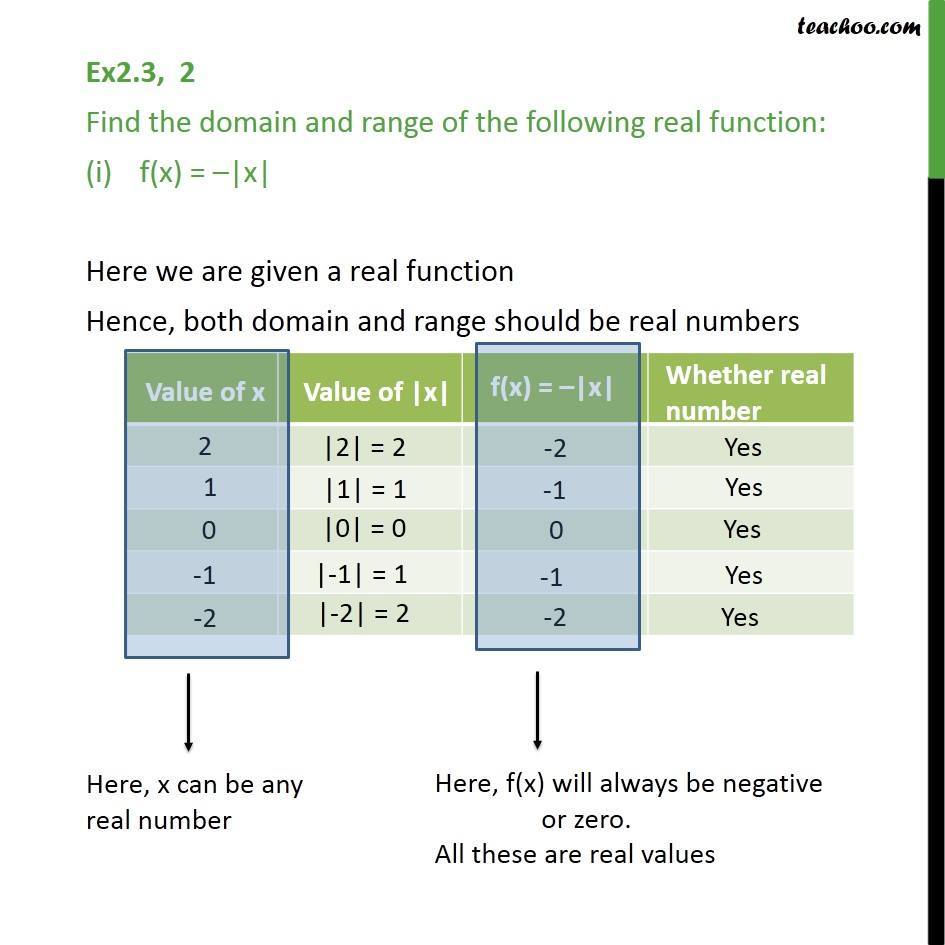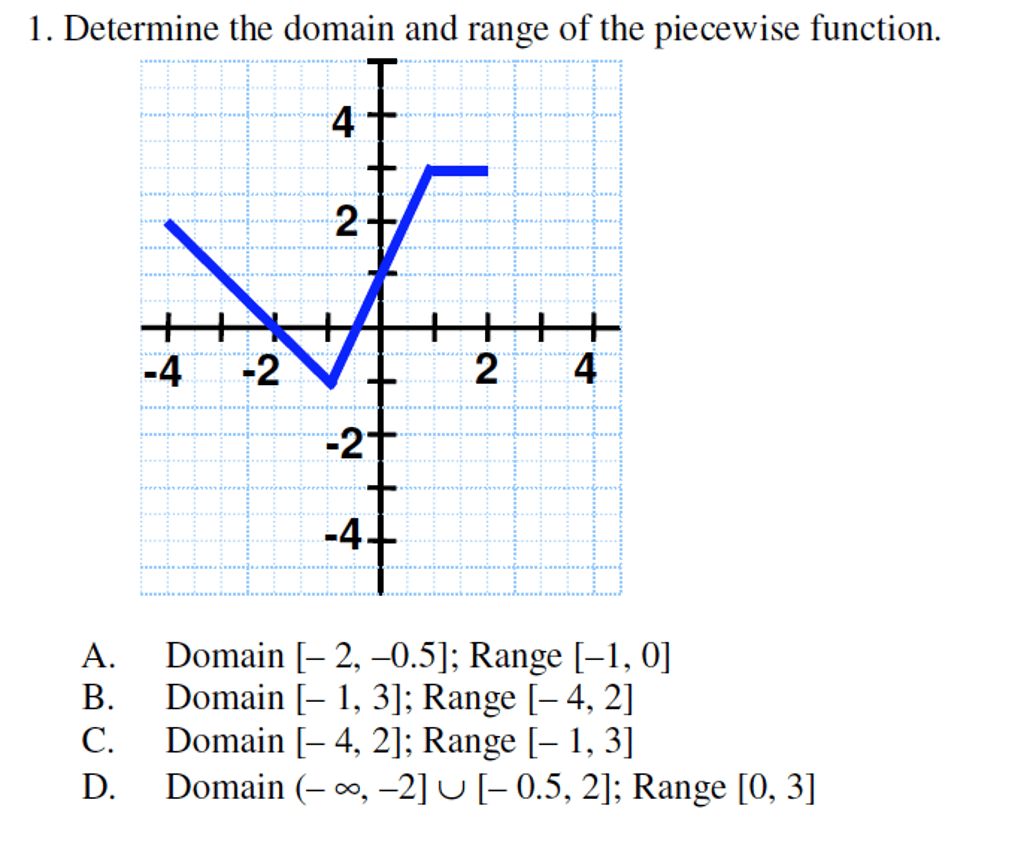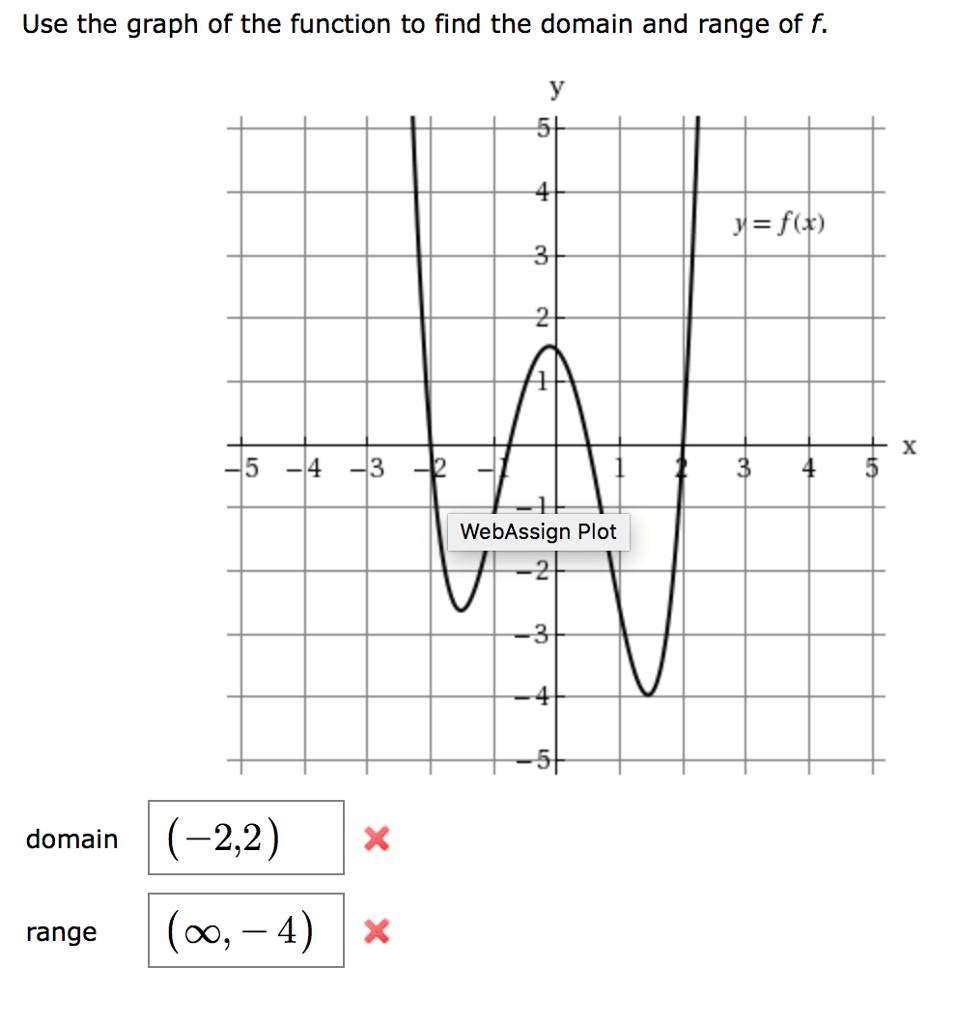Domain And Range Of A Function
The domain and range of a function are the components of a function. The domain is the set of all the input values of a function and range is the possible output given by the function. Domain Function Range. If there exists a function f: A B such that every element of A is mapped to elements in B, then A is the domain and B is the co-domain. The image of an element ‘a’ under a relation R is given by ‘b’, where R. The range of the function is the set of images. The domain and range of a function is denoted in general as follows: Domain = and range=
The domain and range of this function f = 2x is given as domain D = , range R =
Examples On Domain And Range
Example 1. Find the domain and range of the real function f defined by f =
Solution: Given the function is real. Thus the domain and range of the function are also real.
| x | |
|---|---|
| = -3 | No |
The minimum value it could take is 1 and the maximum value is . Thus domain = [1, ).
Since f is always non-negative, the minimum value of the range is 0 and it can range up to infinity. Thus range = [0, )
Answer: The domain and the range of the function f defined by f = is domain = [1, ) and range = [0, )
Example 2: We define a function f: R-0 R as f=1/x. Complete the table shown below. Find the domain and range of the function.
| x |
|---|
Solution:
Let’s complete the given table by finding the values of the function at the given values x. Plugging in the values of x in the given function, we find the range of f = 1/x.
| x | |
|---|---|
| 2 | 0.5 |
Let’s draw the graph of the function to determine the domain and range of the function.
Answer: From the graph, we can observe that the domain and range of the function are all real numbers except 0. So, the domain and range of f=1/x is R-
Finding The Range Of A Function In A Word Problem
You May Like: Where To Buy Expired Domains
Domain And Range Of Trigonometric Functions
Look at the graph of the sine function and cosine function. Notice that the value of the functions oscillates between -1 and 1 and it is defined for all real numbers.
Thus, for each of the sine and cosine functions:
- Domain: The domain of the functions is the set R.
- Range: The range of the functions is
Finding Domain And Range Without Using A Graph

It’s always a lot easier to work out the domain and range when reading it off the graph . However, we don’t always have access to graphing software, and sketching a graph usually requires knowing about discontinuities and so on first anyway.
As meantioned earlier, the key things to check for are:
You May Like: What Is Domain In Email Address
Find The Domain And Range Of Special Functions
Rational Function: A rational function is defined for only the non-zero values of the denominator.
Square Root Function: A square root function is defined for only the non-negative values of the expression under the radical symbol.
What Is The Domain Codomain And Range Of A Function
The set of elements in \ that are plugged into the function \ is called the domain.
The set \ that is a collection of possible outcomes is called the codomain. The set of images of the elements in \, which is a subset of \ is called the range of the function \
Range \
For the function \
Domain \
Codomain \
Range \
Don’t Miss: What To Do With A Domain Name
Domain And Range Of Toolkit Functions
We will now return to our set of toolkit functions to determine the domain and range of each.
For the constant function f\left=c, the domain consists of all real numbers there are no restrictions on the input. The only output value is the constant c, so the range is the set \left\ that contains this single element. In interval notation, this is written as \left, the interval that both begins and ends with c.
For the identity function f\left=x, there is no restriction on x. Both the domain and range are the set of all real numbers.
For the absolute value function f\left=|x|, there is no restriction on x. However, because absolute value is defined as a distance from 0, the output can only be greater than or equal to 0.
For the quadratic function f\left=^, the domain is all real numbers since the horizontal extent of the graph is the whole real number line. Because the graph does not include any negative values for the range, the range is only nonnegative real numbers.
For the cubic function f\left=^, the domain is all real numbers because the horizontal extent of the graph is the whole real number line. The same applies to the vertical extent of the graph, so the domain and range include all real numbers.
For the cube root function f\left=\sqrt, the domain and range include all real numbers. Note that there is no problem taking a cube root, or any odd-integer root, of a negative number, and the resulting output is negative .
How To Find The Range Of A Function
The range is the set of images of the elements in the domain.
To find the range of a function:
- Step 1: Write down the function in the form \\)
- Step 2: Solve it for \ to write it in the form, \\)
- Step 3: The domain of the function \\) is the range of \\).
Example: For the function \=\log x\), the image takes up the values from \ to \. That is, the range of the function is the set of all real numbers.
Recommended Reading: How Much Is It To Purchase A Domain Name
Finding The Domain And Range Of A Function: Overview Method Examples
Finding the Domain and Range of a Function: Domain, in mathematics, is referred to as a whole set of imaginable values. These values are independent variables. In other words, in a domain, we have all the possible x-values that will make the function work and will produce real y-values. The range, on the other hand, is set as the whole set of possible yielding values of the depending variable, which in this case, is y .
Finding the domain requires determining the values of the independent variables that have been allowed to use. At the bottom of the fraction, 0 is usually debarred or we generally avoid negative values that are found under the square root sign. The range of a function is considered as an array of possible y-values. Continue reading to learn more about the domain and range of a function.
What Are The Rules To Find The Domain Of A Function
Here are some general rules used to find domain of different types of functions:
- f = polynomial, the domain is the set of all real numbers.
- f = 1/x, domain if the set of all real numbers but x0.
- f = x, domain if the set of all real numbers such that x 0.
- f = ln x, domain is the set of all real numbers such that x > 0.
Also Check: What Does It Mean To Transfer A Domain Name
How To Find The Domain Of A Function
The domain of a function is the values for which the function is defined.
For real-valued functions: first, you need to identify the values for which the function is not defined and then exclude them.
Example: A logarithmic function \=\log x\) is defined only for positive values of \. That is, the domain of the function is the set of positive real numbers. So, that is how it, i.e., domain and range of logarithmic functions, works.
Finding The Domain Of A Function Using A Graph

Recommended Reading: How To Buy A Domain For Shopify
How To Find The Domain
We can determine the domain of the function by looking for the values of the independent variable , which we can use in the function. Usually, this involves avoiding values that produce a 0 in the denominator of fractions or avoiding having negative values within square roots.
Therefore, to find the domain, the important thing to remember is that:
- The denominator of a fraction cannot be zero.
- The number within a square root must be positive.
How To Find The Domain And Range Without Using A Graph
Its always easier to determine the domain and the range of a function when we have a graph, as long as we make sure to zoom in and out to capture all the necessary details. However, graphing a function is not always possible as we may not have software or calculators to graph at any given time.
To find the domain and range without using a graph, we use what we saw earlier:
- We cannot have negative values within a square root sign.
- We cannot have zeros in the denominator of a fraction.
You May Like: How To Get Free Domain Name And Hosting
What Is Domain And Range
The domain and range are defined for a relation and they are the sets of all the x-coordinates and all the y-coordinates of ordered pairs respectively. For example, if the relation is, R = , then:
- Domain = the set of all x-coordinates =
- Range = the set of all y-coordinates =
We can visualize this here:
Find The Domain And Range From Equations
Let \\) be the function we need to find the domain and the range.
Step 1: Solve the equation to determine the values of the independent variable \ and obtain the domain.
Step 2: To calculate the range, rewrite the equation \\) with the independent variable \ expressed in terms of \. That is, in the form \\). Now, the domain of the function \\) is the range of the function \\).
Read Also: Do You Have To Register A Domain Name
Finding The Range Of A Quadratic Function
The Importance Of Codomain
Let me ask you a question: Is square root a function?
If we say the codomain is the set of real numbers, then square root is not a function! … is that a surprise?
The reason is that there could be two answers for one input, for example f = 3 or -3
A function must be single valued. It cannot give back 2 or more results for the same input. So “f = 3 or -3″ is not right!
But it can be fixed by simply limiting the codomain to non-negative real numbers.
In fact, the radical symbol always means the principal square root, so x is a function because its codomain is correct.
So, what we choose for the codomain can actually affect whether something is a function or not.
Read Also: Who Is My Domain Name Provider
Domain And Range Of An Absolute Value Function
The function y=|ax+b| is defined for all real numbers. So, the domain of the absolute value function is the set of all real numbers. The absolute value of a number always results in a non-negative value. Thus, the range of an absolute value function of the form y= |ax+b| is y R | y 0. The domain and range of an absolute value function are given as follows
Example: |6-x|
- Domain: The domain of the function is the set R.
- Range: We already know that the absolute value function results in a non-negative value always. i.e., |6-x| 0, for all x.
What Is The Domain And Range Of Composite Functions

Let the composite function be \. The domain and range of h are determined as follows. The domain of h is either same as f or lies within the domain of f. The range h must lie within the range of g. Let f = x2 and g = x+ 3. We know that f: X Y and g: Y Z. Then fog: X Z. f) = 2. Thus the domain and range are: domain= , range=
Don’t Miss: How To Find Domain Ownership History
Finding The Domain Of A Function Defined By An Equation
In Functions and Function Notation, we were introduced to the concepts of domain and range. In this section, we will practice determining domains and ranges for specific functions. Keep in mind that, in determining domains and ranges, we need to consider what is physically possible or meaningful in real-world examples, such as tickets sales and year in the horror movie example above. We also need to consider what is mathematically permitted. For example, we cannot include any input value that leads us to take an even root of a negative number if the domain and range consist of real numbers. Or in a function expressed as a formula, we cannot include any input value in the domain that would lead us to divide by 0.
We can visualize the domain as a âholding areaâ that contains âraw materialsâ for a âfunction machineâ and the range as another âholding areaâ for the machineâs products ).
We can write the domain and range in interval notation, which uses values within brackets to describe a set of numbers. In interval notation, we use a square bracket \). We will discuss interval notation in greater detail later.
Before we begin, let us review the conventions of interval notation:
See Figure \ for a summary of interval notation.
Example \: Finding the Domain of a Function as a Set of Ordered Pairs
Find the domain of the following function: \.
Solution
Find the domain of the function:
- Answer
How To: Given a function written in equation form, find the domain.